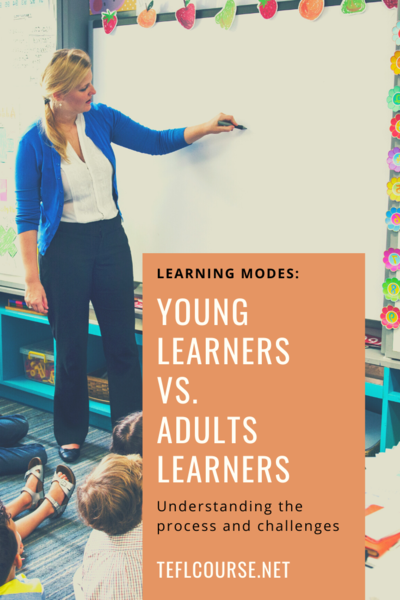Learning Modes: Young Learners vs. Adults Learners

Although the Classroom Learning Modes are affected by many variables, a large factor that instructors should be aware of are the differences and similarities between Youth and Adult Learners. Youth versus adult learners may vary in their classroom experience, energy, and sources of motivation, however, all students (regardless of age) can learn successfully if the teacher is cognizant of these dimensions as they design and deliver their course.
Table of Contents
Do you want to teach English abroad? Take a TEFL course!
This post was written by our TEFL certification graduate Julia J. Please note that this blog post might not necessarily represent the beliefs or opinions of ITTT.
Benefits of Younger Students
Young English learners typically possess less classroom experience than more mature learners, however, this tends to make young learners not only more impressionable but more adaptable to classroom expectations. Their (often high) energy is complemented by a willingness and openness to engage on a more playful level with many of the activities introduced in the classroom. However, their sources of motivation are more frequently generally external, rather than intrinsic. They might find themselves in the classroom due to school mandates or their parents may have enrolled them. That is not to say that every young student studies for external reasons. Often student's display a high level of intrinsic motivation because they genuinely desire to communicate or to understand music and movies that surround them daily. Some very progressive-minded students already have future careers in mind and plan to travel the world, for which they intrinsically value knowledge of English is an asset.

Also Read: 5 Things You Can Overcome If You Prepare Your Lesson Plan
Pros to Teach Older Students
In contrast, Adult Learners often possess a high level of classroom experience, may express a bit more of a mellowed or paced energy, and are almost always intrinsically motivated to learn the language. Not only can Adult Learners see a monetary value (in terms of course fees), but they also often have quite specific goals in mind. These can range from business aspirations to university entrance exams to dreams of vacation in faraway places, or even the desire to learn the language of a spouse, partner, or close friend. There is certainly a wide variety of reasons why an adult learner may be present in an English course. As an instructor, discovering one's students' motivations can help create the student-instructor bond while also providing valuable insights (for the professor) as to the needs of the individual in the classroom.
Also Read: Features of Teaching EFL in a Kindergarten
Other Factors
Regardless of the age perspective, instructors must remember that students, particularly beginning language students, may possess or perceive a certain vulnerability when they initially enroll in the class. Although they may come from a different set of backgrounds and experiences, be they fresh or thoroughly embedded, there is a certain self-consciousness that can accompany learning a new language. Even for students with an extremely confident and experimental approach or learning style, they will still face moments of frustration which can manifest differently depending upon whether the students are younger or older, among other variables. For example, a young learner may express their frustration by acting out or withdrawing from the group if they feel anxious that they are falling behind. For both age categories, however, it is important to be as inclusive as possible and not to leave students abandoned. If more time or energy is needed for a particular topic, then this should be addressed before moving forward and creating further inequity in the classroom. The teacher should try to be aware of the circumstance before when students are at risk of hitting the 'shut down' point. Old or young—we've all been there!
Do you want to teach English abroad? Take a TEFL course!
While it is the students' responsibility to be a 'ready-learner,' the teacher must acknowledge that they really cannot control what has or has not shaped the mindset of their students before their enrollment in the class. For this reason, it becomes the responsibility of the teacher to read the room and to discover the best ways to create an environment where the students can flourish and elicit students' best work to the maximum extent possible. In sum, whether or not a teacher finds themselves in front of a classroom of young or mature learners, they must recognize that they are in front of the budding speakers of a new language who will face needs unique to their demographic along their respective journeys to fluency.
Apply now & get certified to teach english abroad!
Speak with an ITTT advisor today to put together your personal plan for teaching English abroad.
Send us an email or call us toll-free at 1-800-490-0531 to speak with an ITTT advisor today.
Related Articles:
- 10 Questions You Need to Ask Before Enrolling In a TEFL Course
- The 10 Best Destinations for Teaching English Abroad in 2018
- 6 Tips You Need to Know About Jobs Teaching English Abroad
- The Best Government Programs For Teaching English Abroad
- What Scams to Look Out for When Looking for TEFL Jobs
- The Best Countries for Single Women to Teach English Abroad




